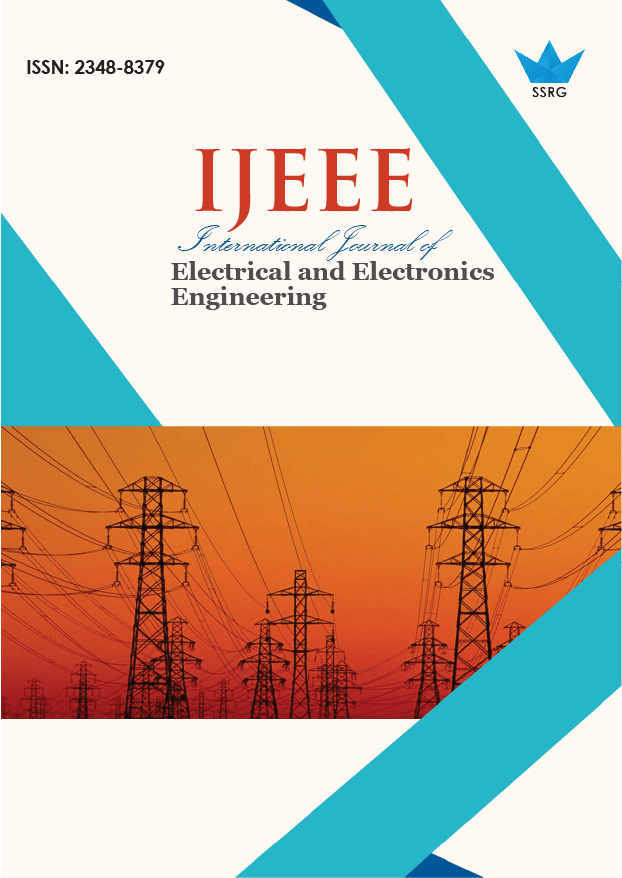Development of an Adaptive AI-Enhanced Prosthetic Arm for Physically Impaired Children

| International Journal of Electrical and Electronics Engineering |
| © 2025 by SSRG - IJEEE Journal |
| Volume 12 Issue 3 |
| Year of Publication : 2025 |
| Authors : Manal Al Khaldi, Tariq Al Balushi, Amin Al Maqbali, Amuthakkannan Rajakannu |
How to Cite?
Manal Al Khaldi, Tariq Al Balushi, Amin Al Maqbali, Amuthakkannan Rajakannu, "Development of an Adaptive AI-Enhanced Prosthetic Arm for Physically Impaired Children," SSRG International Journal of Electrical and Electronics Engineering, vol. 12, no. 3, pp. 114-127, 2025. Crossref, https://doi.org/10.14445/23488379/IJEEE-V12I3P112
Abstract:
This research addresses the critical gap in pediatric prosthetics for children by developing an adaptive prosthetic arm tailored to children aged 7 to 14, a demographic often overlooked in prosthetic innovation. Rapid physical growth during this age requires frequent adjustment and more medical care. Because of the requirement for frequent adjustment, pediatric prosthetics are more complex than adult models. Existing solutions have disadvantages, such as difficulty adapting adult designs and lack of the ergonomic, functional, and psychological considerations required for children. This work introduces a novel prosthetic arm that integrates Artificial Intelligence (AI) and Deep Learning (DL) to enhance adaptability, control, and user experience. In the initial phase of the work, the existing models and their disadvantages were considered. Then, the new design is developed, which leverages biosensors and electromyographic (EMG) signals for intuitive gesture recognition, enabling tasks such as gripping, pinching, and twisting. After developing the design, a 3D printer was used to create the arm. The arm was tested in real-time, and the AI developed with the prosthetic arm showed a promising overall accuracy of 91%. This shows the design and other components’ accuracy and that the proposed arm design can be implemented for pediatric prosthetics.
Keywords:
Prosthetics, Artificial Intelligence, Machine Learning, Pediatric healthcare, AI algorithms, Oman vision 2040
References:
[1] K.P.N.V. Satya Sree et al., “EMG Controlled Bionic Robotic Arm using Artificial Intelligence and Machine Learning,” IEEE Fifth International Conference on IoT in Social, Mobile, Analytics and Cloud, Palladam, India, 2021.
[CrossRef] [Google Scholar] [Publisher Link]
[2] Karla Avilés-Mendoza et al., “A 3D Printed, Bionic Hand Powered by EMG Signals and Controlled by an Online Neural Network,” Biomimetics, vol. 8, no. 2, pp. 1-33, 2023.
[CrossRef] [Google Scholar] [Publisher Link]
[3] Neelum Yousaf Sattar et al., “EMG-Based Control of Transhumeral Prosthesis Using Machine Learning Algorithms,” International Journal of Control, Automation and Systems, vol. 19, pp. 3522-3532, 2021.
[CrossRef] [Google Scholar] [Publisher Link]
[4] Jethro Odeyemi et al., “On Automated Object Grasping for Intelligent Prosthetic Hands Using Machine Learning,” Bioengineering, vol. 11, no. 2, pp.1-18, 2024.
[CrossRef] [Google Scholar] [Publisher Link]
[5] Narek N. Unanyan, and Alexey A. Belov, “|Low-Price Prosthetic Hand Controlled by EMG Signals,” IFAC-PapersOnLine, vol. 54, no.. 13, pp. 299-304, 2021.
[CrossRef] [Google Scholar] [Publisher Link]
[6] Amira J. Zalyaa et al., AI-Based Bionic Prosthesis Design: Neural Networks for EMG Gesture Customization,” BAU Journal-Science and Technology, vol. 6, no. 1, pp. 1-21, 2024.
[CrossRef] [Google Scholar] [Publisher Link]
[7] Ke Xu et al., “A Prosthetic Arm Based on EMG Pattern Recognition,” IEEE International Conference on Robotics and Biomimetics (ROBIO), Qingdao, China, pp. 1179-1184, 2016.
[CrossRef] [Google Scholar] [Publisher Link]
[8] Jimmy Lu et al., Real-Time Bionic Arm Control via CNN-Based EMG Recognition, Hackster.io, 2022. [Online]. Available: https://www.hackster.io/emgarm/real-time-bionic-arm-control-via-cnn-based-emg-recognition-b013d3
[9] K. Murugan et al., “Electromyography Controlled Smart Prosthetic Arm,” Third International Conference on Intelligent Techniques in Control, Optimization and Signal Processing (INCOS), Tamil Nadu, India, pp. 1-6, 2024.
[CrossRef] [Google Scholar] [Publisher Link]
[10] J. Fuentes-Gonzalez et al., “A 3D-Printed EEG Based Prosthetic Arm,” IEEE International Conference on E-health Networking, Application & Services (HEALTHCOM), Shenzhen, China, pp. 1-5, 2021.
[CrossRef] [Google Scholar] [Publisher Link]
[11] Péricles Valera Rialto Júnior et al., “Automated Forearm Prosthesis Controlling Using Fiber Bragg Grating Sensor,” Journal of Microwaves, Optoelectronics and Electromagnetic Applications, vol. 22, no. 1, pp. 208-218, 2023.
[CrossRef] [Google Scholar] [Publisher Link]
[12] Pranesh Gopal, Amandine Gesta, and Abolfazl Mohebbi, “A Systematic Study on Electromyography-Based Hand Gesture Recognition for Assistive Robots Using Deep Learning and Machine Learning Models,” Sensors, vol. 22, no. 10, pp. 1-13, 2022.
[CrossRef] [Google Scholar] [Publisher Link]
[13] Mehrshad Zandigohar et al., “Multimodal Fusion of EMG and Vision for Human Grasp Intent Inference in Prosthetic Hand Control,” Frontiers in Robotics and AI, vol. 11, pp. 1-18, 2024.
[CrossRef] [Google Scholar] [Publisher Link]
[14] Shuo Jiang et al., “Emerging Wearable Interfaces and Algorithms for Hand Gesture Recognition: A Survey,” IEEE Reviews in Biomedical Engineering, vol. 15, pp. 85-102, 2022.
[CrossRef] [Google Scholar] [Publisher Link]
[15] Shivani Guptasarma, and Monroe D. Kennedy III, “ProACT: An Augmented Reality Testbed for Intelligent Prosthetic Arms,” arXiv Preprint, 2024.
[CrossRef] [Google Scholar] [Publisher Link]
[16] Kai Guo et al., “The latest Research Progress on Bionic Artificial Hands: A Systematic Review,”Micromachines, vol. 15, no. 7, pp. 1-23, 2024.
[CrossRef] [Google Scholar] [Publisher Link]
[17] Md Abdul Baset Sarker et al., “Vision Controlled Sensorized Prosthetic Hand,” arXiv Preprint, 2024.
[CrossRef] [Google Scholar] [Publisher Link]
[18] Vaheh Nazari, and Yong-Ping Zheng, “ProRuka: A Highly Efficient HMI Algorithm for Controlling A Novel Prosthetic Hand with 6 DOF Using Sonomyography,”arXiv Preprint, 2024.
[CrossRef] [Google Scholar] [Publisher Link]

 10.14445/23488379/IJEEE-V12I3P112
10.14445/23488379/IJEEE-V12I3P112